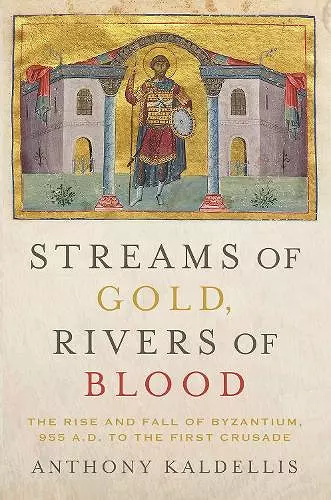Streams of Gold, Rivers of Blood
The Rise and Fall of Byzantium, 955 A.D. to the First Crusade
Format:Paperback
Publisher:Oxford University Press Inc
Published:10th Oct '19
Currently unavailable, and unfortunately no date known when it will be back

In the second half of the tenth century, Byzantium embarked on a series of spectacular conquests: first in the southeast against the Arabs, then in Bulgaria, and finally in the Georgian and Armenian lands. By the early eleventh century, the empire was the most powerful state in the Mediterranean. It was also expanding economically, demographically, and, in time, intellectually as well. Yet this imperial project came to a crashing collapse fifty years later, when political disunity, fiscal mismanagement, and defeat at the hands of the Seljuks in the east and the Normans in the west brought an end to Byzantine hegemony. By 1081, not only was its dominance of southern Italy, the Balkans, Caucasus, and northern Mesopotamia over but Byzantium's very existence was threatened. How did this dramatic transformation happen? Based on a close examination of the relevant sources, this history-the first of its kind in over a century-offers a new reconstruction of the key events and crucial reigns as well as a different model for understanding imperial politics and wars, both civil and foreign. In addition to providing a badly needed narrative of this critical period of Byzantine history, Streams of Gold, Rivers of Blood offers new interpretations of key topics relevant to the medieval era. The narrative unfolds in three parts: the first covers the years 955-1025, a period of imperial conquest and consolidation of authority under the great emperor Basil "the Bulgar-Slayer." The second (1025-1059) examines the dispersal of centralized authority in Constantinople as well as the emergence of new foreign enemies (Pechenegs, Seljuks, and Normans). The last section chronicles the spectacular collapse of the empire during the second half of the eleventh century, concluding with a look at the First Crusade and its consequences for Byzantine relations with the powers of Western Europe. This briskly paced and thoroughly investigated narrative vividly brings to life one of the most exciting and transformative eras of medieval history.
...very useful and readable book ... Summing Up: Essential. Upper-division undergraduates and above. * R. T. Ingoglia, CHOICE *
A stylish and fast-paced narrative that weaves politics, society, and individual characters together into a fascinating depiction of a lively, dynamic, and culturally diverse civilization at its height. Firmly rooted in the contemporary sources and with a well-tuned appreciation of current scholarly debates, Kaldellis' account is set to become the standard 'go-to' political narrative of the medieval eastern Roman or Byzantine empire in its heyday. * John F. Haldon, Princeton University *
A learned and critical reassessment of the standard narrative, which is at the same time an engaging and lively account of an exciting period in the history of Byzantium. * Paul Magdalino, University of St. Andrews *
Anthony Kaldellis' new history of Byzantium is a major achievement. By setting aside the pre-conceptions of much of the secondary literature, and returning to the sources, he is able to reconstruct the dynamics of imperial power and politics across the crucial years between the imperial expansion of the late tenth century and the First Crusade. This book will be required reading for students and scholars not only of Byzantium, but also of the Medieval West. * Peter Sarris, University of Cambridge *
In this lucid and well-researched history, Kaldellis, a classics scholar, examines the rapid expansion and subsequent contraction of Byzantium in the 10th and 11th centuries. This work serves impressively as both a general introduction to the political, economic, and military history of the period and a narratively engaging and clear interpretation of the causes and effects of the empire's rise and fall. The book nicely balances explication and commentary; Kaldellis includes details that bring his history to life-such as the facial hair patterns of a Byzantine enemy...The work is thus both educational and enjoyable, almost a canonical model of how to write history for both lay and professional readers. This is a welcome introduction to Byzantine history, which is little known in the West relative to earlier Greek or Roman periods and deserves wider understanding and discussion. * Publisher's Weekly *
ISBN: 9780190053208
Dimensions: 234mm x 155mm x 31mm
Weight: 635g
440 pages